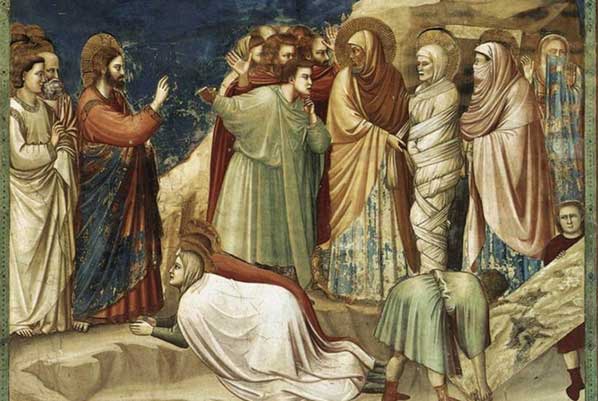Over the years, both in and out of the church, I have been subjected to a lot of “Leadership studies”. Much of it was interesting, especially the psychological material, but some of it seemed to be rather separate from the real world of trying to engage busy colleagues with a variety of “Opinions” in change across a culture.
Whatever you think about Jesus I guess he must have been a superb leader – not many can claim a legacy of change like his. I was particularly interested in what drove him – how did he keep focus when he was pulled in so many directions by so many people, and just what was he aiming at anyway? When he closed his eyes and day dreamed what was he thinking about?
This was one long title… “Describe and reflect critically on the contribution of Jesus of Nazareth and the study of his life to an understanding of leadership today with specific reference to you own, somebody else’s or a community’s development”
The Raising of Lazarus, Giotto, ~ 1304
What is leadership?
The nature of leadership is much discussed and studied. Adair states that a ‘leader is the person whom in one form or other, shows the way on [a] common journey’[1], whilst Ford adds that leaders ‘initiate ideas and plans’.[2] Blanchard and Hodges regard leadership as a ‘process of influence’[3] and divide leadership into two spheres which they call ‘life’ and ‘organisational’.[4] ‘Life leadership’ roles include those areas where responsibility cannot easily be laid down, such as being a parent, friend or spouse. ‘Organisational leadership’ roles are more hierarchal, and tend to be shorter in term. Blanchard and Hodges conclusion is that since leadership is about influence, we are all leaders.
Issues facing Leaders
Blanchard and Hodges believe that the ‘world is in desperate need of a different leadership role model’.[5] In common with all of us, leaders struggle with the snares of pride, arrogance and self-service, along with the ‘compulsions of the world to be relevant, spectacular and powerful’.[6] When organisational leaders fall to these temptations we have only to look at the litany of dictators and failed organisations to see the results. Repeatedly the media informs us that our political leaders are ‘out of touch’, unable to identify with the ‘working man’, and it is suggested that many believe the ‘sheep are there only for the benefit of the shepherd’.[7] Assuming that Jesus is our prime example of leadership, how did he avoid these problems and how was his leadership of a different nature? What model of leadership does he set out for us?
The Vision of Jesus
Adair tells us that as ‘humans we have the capacity to imagine a better future…it is the function of leaders to have vision in this way’.[8] Great leaders have a strong sense of purpose and we can see that Jesus was no exception. His vision of the ‘kingdom of God on earth’ is illustrated by his first recorded words in Mark’s gospel – ‘the kingdom of God is at hand; repent and believe in the gospel’. (Mk1:15) This vision permeated everything that Jesus did – his teaching, ministry and interactions with people. This ‘master thought’,[9] the constant desire to see the breaking in of the rule of God into peoples’ lives, seems to have been constantly in Jesus’ thoughts and motivated all that he did.
It has become clearer to me just how important vision was to the leadership of Jesus. It can be stated in a negative light as in ‘where there is no vision, the people perish’ (Pro 29:18) but there is a powerful positive side to it too. This great vision to ‘set people free from all that binds them’[10] empowered Jesus, ‘who for the joy that was set before him endured the cross’. (Heb12:2) The vision Jesus had of the kingdom of God coming near to people in the here and now, and later being fully established, enabled Jesus the leader to stand up to the religious authorities of his day, to have peace in the midst of extreme business, and to disentangle himself from the need to be ‘spectacular and powerful’.
Of course, Jesus had many more attributes that contributed to his leadership style, but it’s worth reflecting on the strength of his intense, almost driving vision. I remember as a main scale teacher seeing an advert for an internal promotion. At the time I was quite satisfied with what I was doing, but as I read and re-read the advert it was as if a voice said to me ‘You could do that’. Where there had been no vision, one became implanted in me and so began my advance into leadership within the profession.
The Identity of Jesus
According to Adair, the Chinese philosopher Lao Tzu thought ‘it is always some want within the inner life of the ruler that causes trouble among the people. If the leader lacks faith or trust, so will the people.’[11] Some of these ‘inner’ difficulties spring from our upbringing, simply because even though they loved us greatly, our care-givers are not perfect. One suspects the same was true for Jesus’ parents, which naturally raises many questions such as could Jesus have been sinless yet had such inner difficulties and if so how would they have impacted his leadership?
At his baptism, Jesus heard the words ‘this is my beloved Son, with whom I am well pleased’. (Mat 3:17) This message was repeated at the transfiguration. (Mat 17:5) In both these instances Jesus received a profound re-affirmation of who he was. Ford says that ‘the strongest leaders are those who have received a strong affirmation of their personhood’[12], and since Jesus knew who he was he was able to stay focused when his leadership seemed under threat.
How did Jesus feel when members of his own family thought that he was out of his mind (Mk 3:21), or when the crown of thorns was pushed into his skull? The affirmation that his father had spoken to him must have bought comfort as he wrestled with these ‘inner’ difficulties. The deep sense of knowing who he was enabled him to continue his mission.
In teaching we used to say that you had to give a pupil a number of positive comments to every negative one. Whilst important, this was not so much to make the pupil feel, but rather to keep building their confidence. I remember a physics teacher saying to me how well I had done in a test when I was aged twelve. This was a surprise to me, but not to him it seemed. That simple moment of affirmation from a respected authority figure led to my pursuing science options rather than arts. In my case, knowing I was good at physics gave me the confidence to keep going when my grades didn’t reflect it! Whilst perhaps a small example, it does illustrate the power of knowing who you are.
Jesus Empowered
Ford describes how Jesus appears to have had both short and long term goals. He relates this to Jesus creating a beachhead with a small number of people so that eventually the whole world can be conquered.[13] Jesus completely identified with his disciples, the common people, as he left the glory to become one of them, living like they did. In some ways it was easy for the disciples to relate to him; how much harder would it have been to win the common people if he was a say a prince? This common touch empowered his disciples in that it opened up the possibility of their learning from him.
Jesus teaching style has been described as a ‘living classroom’ in which the disciples could quite literally ‘see one, do one’ and in which he tested them too – ‘you feed them’ he said in Mat 14:16.[14] He invested heavily into this small group, and they watched him, and were sent out to continue his kingdom-bringing work. Afterwards Jesus would take time to go over what had happened.
Sometime teachers/leaders have a tendency to dominate, requiring unquestioning obedience. Crucially Jesus says to his disciples
no longer do I call you servants, for the servant does not know what his master is doing; but I have called you friends, for all that I have heard from my Father I have made known to you. (John 15:15)
It is hard to maintain hierarchy within friendship and Adair believes that with Jesus the disciples were more or less equal and free to think and do what they liked, thereby making them far more likely to respond positively to Jesus.[15] This was a risky strategy that would pay dividends if it worked, but raises the interesting question ‘did Jesus fail in his leadership strategy with Judas?’[16]
It seems clear that as Jesus empowered the disciples he was thinking of ‘successor planning’, creating those who would be ready to continue his mission after he has gone. Once the disciples had received the Holy Spirit, as affirmation and empowerment, they turned the world upside-down.
When I was a year head at a large secondary school I was appointed an assistant who was very capable and lacked nothing except experience. I was able to provide him with a ‘living classroom’ and he soon was able to take on more or the roles required thereby preparing him for promotion.
Jesus the Servant
Blanchard and Hodges say ‘Jesus calls us to follow as leaders; to serve rather than be served’[17] and Adair concurs with ‘a leader is essentially a servant’.[18] Jesus himself says that ‘the Son of Man came not to be served but to serve, and to give his life as a ransom for many.’ (Mk 10:45) His loving interactions with outcasts – lepers, tax collectors, prostitutes – underline his meek and gentle servant attitude. You can almost feel his delight as the kingdom of God draws near to the ‘poor in spirit’.
When the disciples were arguing about who was the greatest Jesus replied by saying ‘if anyone would be first, he must be last of all and servant of all’. (Mk 9:35) This is really counter-cultural; leaders of his day would not wash their disciples’ feet, continue to poor themselves out when exhausted, and spend time with children. Whilst there are examples of servant leaders such as Ghandi, Mandela and Mother Teresa, it’s doubtful if many leaders of today would do these things if there was nothing to gain from them.
Jesus and our Leadership
Ford asks to what extent is Jesus meant to be a leadership role model to us given our innate sense of inadequacy and his perfection? Does this not imply that the Jesus leadership model is a ‘model of despair’?[19] Ford goes onto list several answers to this, all of which are convincing, but then says ‘Jesus’ leadership is not a how to for secular goals, it is uniquely a leadership related to the dynamic of God’s purposes’.[20] The strategy of Jesus was linked with his vision of bringing in the kingdom and, according to Ford, we cannot take it and transfer it to a secular organisation. Blanchard and Hodges would probably not completely concur with this sentiment since they state that servant leadership can bring health and effectiveness to organisations and relationships.[21]
In answering the ‘model of despair’ assertion Adair suggests that whilst Jesus was perfect in that he was sinless, this does not imply that he had all the techniques and attributes of leadership in super, perfected abundance. As a human Jesus would presumably have had to study human nature, and the leadership he saw around him, just as he had to learn carpentry. This throws open the suggestion that maybe he made mistakes within his leadership, perhaps even with Judas? If Jesus made errors of judgement (not in themselves sinful) we can be encouraged us as we seek to ‘lead in the timeless and timely way he pioneered’.[22]
A Reflection
Ford insightfully states that ‘to understand [Jesus’] strategy we must see how it grew out of his mission’.[23] Mission is utterly foundational to leadership, and it seems to me that you need vision if you are going to have a mission. In other words, the vision is behind it all, driving the leader along. Without the vision, the leader is more likely to become derailed when things get tough.
I worked for a visionary head teacher for nine years and it was he who put that job vacancy on the board I previously mentioned. I went into his school as a main scale teacher, and left with an appointment to a senior leadership team. His vision was the development of his staff, because good staff were more likely to be fulfilled leading to improved standards. I, amongst many others, caught his vision.
As already alluded to, Blanchard and Hodges start their book by saying how poor the quality of leadership is at this time, in both the secular and spiritual arenas. Perhaps this has something to do with a lack of vision in some of the people who lead? Speaking personally, I sense a need to catch afresh this continuing vision of Jesus regarding the kingdom of God, and define my specific role(s) within his vision.
Conclusion
Jesus was clearly an outstanding leader, driven by his vision and sense of identity. He was radical in his servant approach, and empowered his ‘team’ in every sense of the word. This essay of course, only scratches the surface of what could be said and I believe that Jesus has much to teach us today about leadership. Whilst it might be impossible to transfer all of his methods to an organisation there are elements of his approach that we can certainly live out in our secular leadership roles.
In summary Adair quotes John Buchan’s simple saying which beautifully sums up the purpose of leadership. ‘The task of leadership is not to put greatness into people, but to elicit it for it is there already.’[24]
Bibliography
Adair, John. The Leadership of Jesus and its Legacy Today. Norwich: Canterbury Press, 2001.
Blanchard, Ken and Hodges, Phil, Lead Like Jesus: Lessons from the Greatest Leadership Role Model of All Time. Kindle Edition. Nashville: W Publishing Group, 2005.
Ford, Leighton. Transforming Leadership: Jesus’ Way of Creating Vision, Shaping Values and Empowering Change. Kindle Edition. Illinois: InterVarsity Press, 1991.
Fernando, Ajith. Jesus Driven Ministry. Nottingham: IVP, 2002 – not cited.
[1] John Adair, The Leadership of Jesus and its Legacy Today (Norwich: Canterbury Press, 2001), p91.
[2] Leighton Ford, Transforming Leadership: Jesus’ Way of Creating Vision, Shaping Values and Empowering Change (Kindle Edition; Illinois: InterVarsity Press, 1991), Loc. 176.
[3] Ken Blanchard and Phil Hodges, Lead Like Jesus: Lessons from the Greatest Leadership Role Model of All Time (Kindle Edition; Nashville: W Publishing Group, 2005), Loc. 145.
[4] Ibid., Loc. 192.
[5] Ibid., Loc. 135.
[6] Ford, Transforming Leadership, Loc. 374.
[7] Blanchard, Hodges, Lead Like Jesus, Loc. 142.
[8] Adair, The Leadership of Jesus, p133.
[9] Ford, Transforming Leadership, Loc. 515.
[10] Ibid., Loc. 780.
[11] Adair, The Leadership of Jesus, p163.
[12] Ford, Transforming Leadership, Loc. 283.
[13] Ibid., Loc. 543.
[14] Ibid., Loc. 631.
[15] Adair, The Leadership of Jesus, p117.
[16] Ibid., p119.
[17] Blanchard, Hodges, Lead Like Jesus, Loc. 147.
[18] Adair, The Leadership of Jesus, p138.
[19] Ford, Transforming Leadership, Loc. 213.
[20] Ibid., Loc. 226.
[21] Blanchard, Hodges, Lead Like Jesus, Loc. 147.
[22] Adair, The Leadership of Jesus, p179.
[23] Ford, Transforming Leadership, Loc. 463.
[24] Adair, The Leadership of Jesus, p182.




